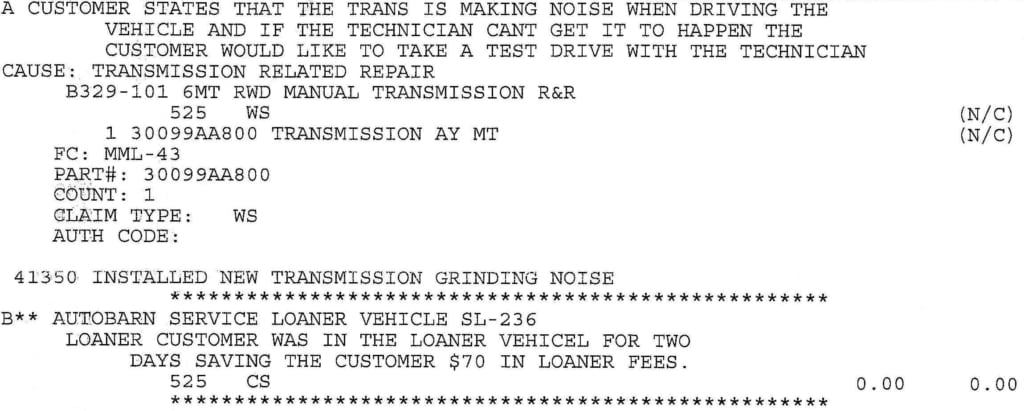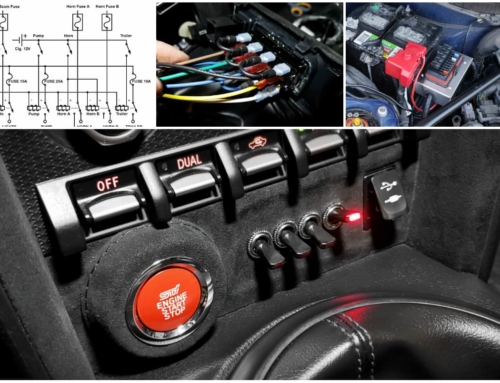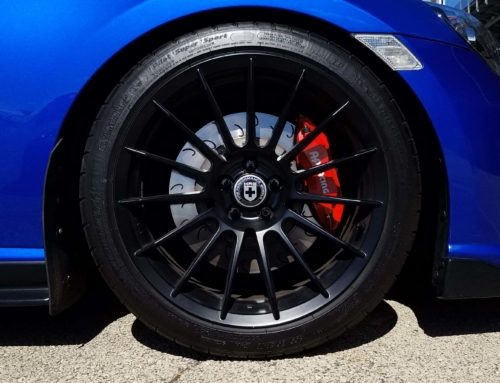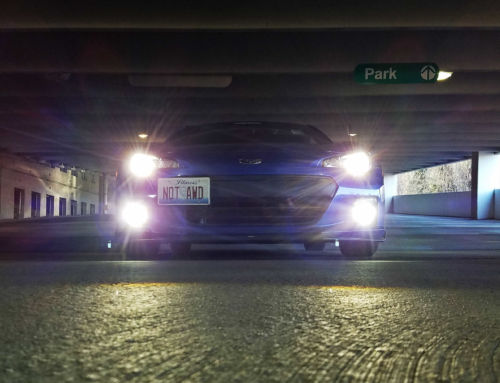Keen-eyed readers will notice that the vehicle in the lead image above is not my BRZ. That’s because it’s the loaner Crosstrek I had the pleasure of driving around in for a few days as a result of my first major repair. It’s a bit of an unusual one for the relatively low mileage that my car has: a brand new transmission.
So what happened? Well, many months, and many thousands of miles ago, I started experiencing an odd issue when upshifting into 4th gear. A very slight rattle coming from the shifter. It was very brief (just a fraction of a second) and occurred as I engaged 4th gear. Because the noise was coming from the shifter assembly itself, I initially ruled out transmission issues. I’d had a problem, ever since I bought the car, where something inside of the shifter rattled when I was accelerating hard above 4k-or-so RPM. I merely assumed that whatever it was had perhaps gotten slightly more loose over time. No big deal. I had been meaning to take the shifter assembly apart and try to track down that rattle, but it had never gotten annoying enough for me to put it at the top of my list.
Anyway, over the next few thousand miles, shifting into 4th became more and more difficult, and the rattle got worse. At first I thought that whatever was loose was starting to get in the way of the shifter, and causing the shifter to hang before engaging 4th. Eventually, though, I started having problems downshifting into 4th as well… and then upshifting ot 5th. At this point, I realized that I needed to do something soon. I posted some questions on FT86Club asking for input, and some folks suggested that what I was experiencing might be synchro failure. I was unconvinced initially. The rattle that I had been hearing sounded exactly like the sound the reverse lockout makes when you lift it up and release it, and I knew for a fact that the sound was coming from the shifter itself. Nonetheless, I decided to do a little test. I went for a drive, and did a whole bunch of shifting to ensure that the problem was repeatable and consistent. Then I did some more shifting, but this time while holding the reverse lockout collar all the way up, thereby preventing it from rattling. Sure enough, that stopped the rattle sound… but unmasked a much more subtle noise that it had been hiding all along: gear grind. Uh oh. You can see and hear this test in the video I took below:
You can see a few things in that video. At 0:14, you can see that I get the shifter rattle in either direction. At 0:36, you can see that pausing between shifts causes the sound to go away (which suggests a synchro issue). At 0:59, you can see that if I pull up on the reverse lockout collar, it eliminates that rattle sound, but uncovers an underlying gearbox grind that would suggest this was indeed a synchro issue. (I will also pre-preemptively point out that I’m not typically that aggressive when shifting. This was the only stretch of road nearby that allowed me to get up to those speeds, so I was trying to do as much back-and-forth through the gears as I could in that short space.)
Now, I’ve been on the forums enough to know that synchro issues are not entirely uncommon with these cars. Not sure why, but it seems like Toyota and AISIN were perhaps a bit too conservative when designing these things. 4th, 5th, and 6th gear seem to be the ones most likely to have issues. I’ve seen quite a few posts about it, and heard of quite a few transmissions having been replaced. In fact, one of my local friends (who also owns a 2015 Series.Blue) got a brand new transmission just a few months ago for a 5th gear grind that was actually worse than mine.
So, off to the dealership I went. The car had 41,350 miles on it when I brought it in. Well within the 60,000 mile power-train warranty limits, but even knowing that, and with all the knowledge of how this isn’t an “uncommon” problem, I was still nervous. First of all, I do all of the normal services to this car myself. There are no “official” records of any maintenance being done by Subaru, or any other shops. Second, I have a big, round SCCA (Sports Car Club of America) sticker on the side, coilovers, a catback exhaust, etc… and I was afraid that they might try to claim that my issues were a result of something I had done (or in the case of the missing service records, something I hadn’t.) As usual, however, my worries were unfounded. Their mechanic took the car for a very brief test drive, and upon returning, they immediately approved the car for a new transmission, and handed me the keys to the Subaru Crosstrek you see above.
I dropped it off on a Thursday, and got it back the following Tuesday. They had to source a new transmission, and at some point while they had it, the battery died, and I had only given them the fob, and not the physical key, so I had to drive to the other side of Chicago to give it to them before they could start working on it. So all of that, plus the weekend, and the turnaround time was rather quick. I was also surprised to only see three additional miles on the odometer from the time I dropped it off, so it’s nice to know they didn’t go and hoon it around for 100 miles just to “test it out.” (I suspect my dashcam installation – with voice prompts on startup – might discourage that kind of behavior.)
In any event, I have the car back now, and it feels like… a new transmission! The shifter is notchy again, as it was when new, and will take some time to break in. The clutch pedal is also quite a bit smoother than it was before, which is a nice added bonus. Basically, all is well, and I can only hope that the synchros in this transmission fare better than the old ones!
Which begs the question: What happened? Well, unfortunately I don’t think I’ll ever know for sure. When the transmission is diagnosed as faulty, and replaced under warranty, it is removed as-is, and shipped off to Subaru’s secret underground bunker to be dissected and analyzed by their minions, and you never hear back. So while I don’t know what the synchros looked like, and whatnot, I can still list all of the potential contributing factors to the failure:
- Manufacturing Defect/Design Flaw: Since we already covered this, I figured I’d start off with it. Plenty of these cars have had similar issues, so it’s possible that this is nothing more than an inherent design flaw that makes the synchros more prone to… not synchroing. Just on the FT86Club forums, there are many threads on this subject, and in some of them you hear reports that the service advisors are “aware” of an issue, though no formal TSB or recall has been issued, as far as I am aware.
- Aftermarket Transmission Fluid: This is something I hadn’t given much thought to, but some recent discussions have left me wondering if it might have been a contributing factor. I changed my transmission fluid at 16,000 miles. I did a lot of research prior to that change to determine which fluid I should use. Our transmission specifies GL-3 fluid, but that is hard to come by these days. It was my understanding that GL-4 was an appropriate replacement. GL-5 should not be used because the additives in it can accelerate the degradation of the brass synchros in our transmissions. I was trying to choose between AMSOIL and Motul, and this wound up being the deciding factor. Motul is rated GL-4 and GL-5. AMSOIL is strictly GL-4. Considering GL-5 spec calls for those increased additives, I’m not sure how a fluid can be rated GL-4 AND 5 (someone had mentioned that they might use additional additives to protect the parts that need GL-4 spec.) In any event, I figured the best option would be the strictly GL-4 fluid, and so I went with AMSOIL. I also decided to change the fluid every 20,000 miles instead of the factory-recommended 30,000 miles. This is because aftermarket fluids, to my understanding, are thinner than the OEM fluid (which explains why people find that the shifter moves more easily after they switch). However, a thinner fluid also protects less. I was talking to a friend, and he postulated that the thinner fluid, coupled with my quicker shifting, could result in greater-than-normal wear on the synchros, since it’s less able to act as a fluid barrier between moving parts. Perhaps that was a contributing factor? In any event, I’ve decided to stick with OEM fluid this time around (especially since I didn’t really notice a difference in shifter feel with AMSOIL anyway.)
- User Error: This is a possibility that can never be ruled out. This is, after all, the first manual transmission car that I ever owned, and while I knew how to drive stick prior to purchasing this car, the vast majority of that experience was driving a 30-year-old school bus with a transmission that had so much play you couldn’t really tell what gear you were going into. As far as this car, though, I’ve always been nice to it. Even back when I had recently purchased the car, I had people compliment me on my smooth shifting. I don’t beat on this car most of the time, so my shifting isn’t slamming into gears 24/7. I do row the gears quite a bit, though. I also use the engine to do pretty much all of my braking, downshifting through the gears as I go (I do this partly for fun, and partly to get as much experience as I can so that I can be as smooth as possible at it. I’ve even started practicing heel-toe downshifts.) I suppose I could be doing something wrong, but I’m not sure what this would be.
As far as what I’m going to do differently this time around: Well, I’m going to stick with the OEM fluid, for starters. I will continue with my 20,000 mile interval fluid changes, as that doesn’t hurt anything. As far as my shifting techniques, I’m not really sure what to change, but I’m relatively confident that I wasn’t doing anything wrong to begin with. Hopefully this was just a transmission issue, and the problem won’t occur again.











Hey, i am experience a slight grind shifting. I bought the brz from a guy and he had a thicker trans oil in it. I recently swapped it to factory spec oil anf within a week i am having grinds unless i wait a full 1 second in neutral before popping it in gear. I am going with its the thinner aftermarket oil. Im going to change it to a thicker oil next weekend and hopefully fixes it. Hope your new transmission is running smooth.
I’m at 51,000 miles, and the new transmission is still fine so far 🙂
Hopefully you get your issues worked out. Are you still under warranty?
I had the exact same problem. Down to the last detail. 4th was a little bit vibraty on the reverse gate from the moment I owned the gar, got so bad that I was driving the thing like a semi truck double clutching every gear to get it to go in. Even had problems with the gears in the order you mentioned. 4th was worst and first, and 5th started having problems later. 6th always slipped a tooth or two, but is significantly taller than 5 so I chalked it up to that. I just got a new transmission installed. It still bangs around pretty bad when its cold, but I’ve revised my shifting technique a bit and it seems to have made a slight improvement.
2nd is still a real problem especially when the engine is cold, and 3 seems to be a bit troublesome now. 5 is as bad as it always was, but 4th is perfect. Who knew…
If I’m not mistaken the transmission is one of the only substantial toyota parts in the drivetrain, out of a lexus IS or something. I really wish they had not allowed them to make that contribution. I’ve owned a lot of manual cars and they have all had perfect transmissions that were awesome to drive. I have not been happy with this one and there are _no_ aftermarket options. Stinks. I’ve been playing with the idea of selling the car but am no nearer to a decision with that than I was 4 months ago. I really like it, and yet I really hate it. Don’t know how to explain that.
Yeah, this being my first manual, I have no baseline for comparison. My new unit “works” now, but I have no idea how it compares to other transmissions. Time will tell if it lasts longer than the first (I really hope so, lol.) Thanks for the background! Always nice to know you aren’t the only one with issues – though in this case, I know we are far from the only ones, lol.
I also like your list of possible causes. That’s the exact same list of possible problems that I came up with. I would really like to think that it’s not my user error, but at the same time the other causes seem just as unlikely so I am not sure what to think. It seems so strange that even the new transmission feels so funny.
Pretty much my feelings :/
Im having 2nd, gear grind within 300km of owning my brand new 2017 BRZ. 3rd and 5th gear syncro is clunky, 1st gear, notchy and reverse gear is slow as fuck. I definitely would not recommend buying this car whatsoever.
Thanks for the comments, Chris. The notchiness will go away somewhat in time; the transmission just needs to be broken in. Where do you live by chance? The only issues I have heard about regarding 2nd are simply that it can be a bit of a PITA in the winter when the transmission is cold until it warms up.
Also, what do you mean by reverse being slow?
Did it fix you rattle above 4k as well?
It seemed to resolve the rattle for a short period of time, but it eventually made its way back (though to a MUCH lesser degree). So… kinda-sorta? Lol.
A lot of shifting issues are caused from clutch drag, ..Your slave cylinder is sticking, maybe air in the hydraulics, or the clutch pedal adjustment rod incorrect. Basically your not getting enough throw from the slave cylinder to clutch fork to disengage the clutch.
This will cause constant CLUTCH drag which will give you shifting isdues, excessive clutch wear damaged syncros, overall a stuffed clutch and gearbox.
They did check the clutch and whatnot and said the engagement and everything was fine. Also the clutch showed no excess wear out of the ordinary. This is just an unfortunately common issue that hopefully won’t return for me. I know quite a few people who have had the exact same issue 🙁